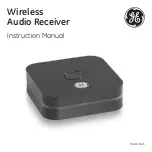
WiNRADiO G35DDC User’s Manual
107
introduction of the world’s first consumer PC-based communications receiver
in 1995, the award-winning
WR-1000i
model – a fully-fledged general-
coverage receiver on a PC card. A serial-interfaced (RS-232) external model
WR-1000e
shortly followed suit. These receivers were little more than software
controlled
(rather than software
defined
): Their functionality, especially those
critical filtering and demodulation functions, was still very much defined by and
dependent on hardware. The software portion of these products was limited to
only two basic functions: To provide a convenient graphical user interface and
to process the audio via a computer sound card.
However, even with this limited added functionality, it was already obvious that
the “marriage” of a radio and computer was inevitable and could produce
some very interesting results: A software-based user interface can be
considerably more powerful than a hardware panel of a conventional receiver,
and computer-based audio processing can provide ancillary functions such as
audio filtering and recording with ease and at little additional cost.
Radio receivers that implement such software control, yet still retain most of
their other functionality defined by hardware, are often classified as
SDR Tier
One
, or
Software-Controlled Radio.
Second Generation SDR
The second generation SDR receivers bring the radio-computer integration a
step further, by including an analog-to-digital converter (ADC) into the
essential functionality of the receiver. This came about primarily as a result of
performance improvement in PC sound cards, as well as increased CPU
power of personal computers that started to rival that of dedicated digital signal
processors (DSPs).
With the second generation of SDR receivers, the output of the final IF stage is
applied to an ADC (either a PC sound card, or included in the receiver), and
the resulting digitized IF signal is then processed further by the host computer
using mathematical digital signal processing (DSP) principles. Such
processing would include filtering and demodulation.
DSP-based filtering has brought two major benefits: A DSP filter can be made
much sharper than a traditional one, resulting in improved selectivity. At the
same time, the filter bandwidth can be made continuously variable, making it
possible to match the filter passband to the actual signal bandwidth and so
maximize the signal-to-noise ratio.
Summary of Contents for WR-G35DDC EXCALIBUR ULTRA
Page 100: ...WiNRADiO G35DDC HF Receiver 100 ...
Page 127: ......
Page 128: ...WiNRADiO C O M M U N I C A T I O N S w w w w i n r a d i o c o m ...
















































